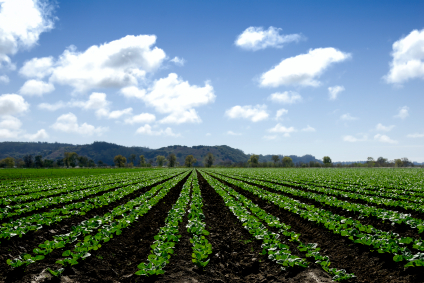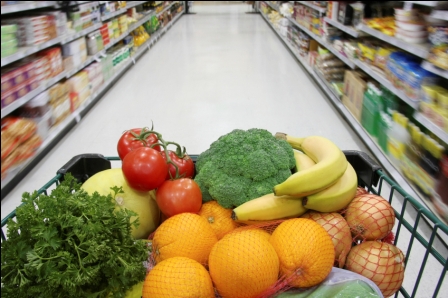|
Food/Beverage LCA and Carbon Footprint Analysis
CleanMetrics now offers an integrated life cycle assessment
(LCA) and carbon footprint solution for the food and beverage industry. Using our standards-based life-cycle inventory database -- including the largest set of commercially available
North American food carbon footprint data -- and our
FoodCarbonScopeTM
LCA software, we can
provide reliable and high-quality assessments of life-cycle carbon footprints
and resource uses for
all food/beverage products and services.
Why Food Carbon Footprints?
 The FAO
reports that agriculture contributes 13.5% of global greenhouse gas emissions
(without including land-use changes). With processing, refrigeration, packaging,
transport and waste disposal added, it is easy to see that foods and beverages
are a major source of national and global emissions as well as personal carbon
footprints. The production and consumption of foods and beverages must therefore
be at the core of any meaningful strategy for climate change mitigation.
Squeezing out waste and inefficiency in the supply, delivery and consumption of
foods/beverages makes both economic and carbon sense -- for businesses and
consumers alike. The FAO
reports that agriculture contributes 13.5% of global greenhouse gas emissions
(without including land-use changes). With processing, refrigeration, packaging,
transport and waste disposal added, it is easy to see that foods and beverages
are a major source of national and global emissions as well as personal carbon
footprints. The production and consumption of foods and beverages must therefore
be at the core of any meaningful strategy for climate change mitigation.
Squeezing out waste and inefficiency in the supply, delivery and consumption of
foods/beverages makes both economic and carbon sense -- for businesses and
consumers alike.
What are Food Carbon Footprints?
The carbon footprint of a food/beverage product or service (sometimes called the
carbon foodprint) is the total amount of
carbon dioxide (CO2) and other greenhouse gases emitted over the life cycle
of that product or service, expressed as kilograms of CO2
equivalents. This includes all greenhouse gases generated in the agricultural
phase -- including emissions from the production and transport of all inputs, as
well as emissions due to on-farm energy use and non-energy-related emissions
(such as methane and nitrous oxide) from soils and livestock. The carbon
footprint also includes the greenhouse gas emissions generated in the processing
and packaging of food/beverage products, and delivery to a point of sale or use
location. For the food service industry -- including restaurants and
institutional cafeterias -- the carbon footprint generally includes the
emissions from meal preparation on site. Finally, waste disposal all along the
supply and consumption chain -- from the farm through processing, transport and consumption --
can add significantly to the life-cycle carbon footprint of
many food/beverage products.
Why CleanMetrics?
 At CleanMetrics, we have worked on a broad range of commercial and academic
projects related to foods and beverages, using life-cycle methods and focused on
carbon footprints and resource use. We have leveraged our
research and software/database expertise, as well as our industry knowledge, to develop the
largest commercially available food carbon footprint database for North America.
Our mission is to help your business address the challenge of sustainable food
production and consumption with the best collection of tools, data and
expertise. At CleanMetrics, we have worked on a broad range of commercial and academic
projects related to foods and beverages, using life-cycle methods and focused on
carbon footprints and resource use. We have leveraged our
research and software/database expertise, as well as our industry knowledge, to develop the
largest commercially available food carbon footprint database for North America.
Our mission is to help your business address the challenge of sustainable food
production and consumption with the best collection of tools, data and
expertise.
The database includes cradle-to-gate and/or unit process data for everything
needed to perform a complete life-cycle carbon,
water and energy footprint analysis of foods and beverages:
-
Over 350 agricultural commodities produced in North America, covering most
of the key production regions, plus another 150 commodities produced in Europe,
Australia and Asia. Commodities include all common grains, vegetables, fruits,
meat, poultry, dairy, seafood, etc.
-
Hundreds of commercial food processing methods and commercial cooking
appliances.
-
Full range of packaging materials, transportation, warehousing, refrigeration,
fuels, and electricity by grid regions.
-
All common solid waste and wastewater disposal methods, including energy
recovery options.
The database is fully integrated with our life-cycle
assessment software tools -- including
FoodCarbonScope, designed specifically for easy analysis of food and
beverage products -- and can be easily customized for your specific
application. We are continually adding data for more products/processes to the
database. We also offer a low-cost rapid research option to add data for
specific products or processes that you may need for your application.
Our Solutions
We offer a range of solutions depending on your needs and in-house expertise.
-
For organizations that are looking for a turn-key solution, we can use our
software tools, database and technical expertise to provide a complete
end-to-end solution
and deliver analytical results tailored for your specific business needs.
-
For organizations with internal expertise in life-cycle assessment and product
carbon footprints, we can license our software products with integrated
life-cycle inventory database. We can also license our
database separately if
you have other means of performing the analyses.
(See our combined software and service
offerings.)
© Copyright 2007-2011 by CleanMetrics Corp. All rights reserved.
CleanMetrics, CargoScope, CarbonScope, BuildingScope, CarbonScopeData,
FoodCarbonScope, Deep Carbon Footprinting, and MetaFlowScope are trademarks of CleanMetrics Corp. |
|
